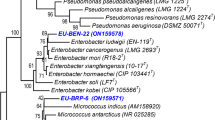Abstract
Enterobacter cloacae was found to be associated with the pollen of several Mediterranean pines. The bacterium was detected only in mature pollen ofPinus halepensis, P. brutia, andP. pinea. E. cloacae is considered to be an obligatory endophyte based on its occurrence in disinfected male cones and the successful inoculation of seedlings of the above 3 species withE. cloacae AS1 isolated from pollen ofP. halepensis used as a model strain. Strain AS1 was able to produce indolyl-3-acetic acid (IAA) froml-tryptophan in culture, and this was probably the source of the increased IAA content in the germination medium of pollen. In addition, strain AS1 promoted adventitious root formation in mung bean (Vigna radiata) cuttings. However, it was not possible to obtain bacterium-free pollen to elucidate its role in pollen germination.
Similar content being viewed by others
Abbreviations
- CFU:
-
colony-forming units
- DCA:
-
deoxycholate agar
- GC-FAME:
-
gas chromatography of fatty-acid methyl esters
- GC-MS:
-
gas chromatography-mass spectrometry
- IAA:
-
indolyl-3-acetic acid
- NA:
-
nutrient agar
- RIA:
-
radioimmunoassay
- SM:
-
synthetic medium
References
Arditti J.: Aspects of the physiology of orchids, pp. 421–655 in H.W. Woolhowse (Ed.):Advances in Botanical Research, Vol. 7. Academic Press, London 1979.
Arshad M., Frankenberger W.T.: Microbial productions of plant hormones.Plant & Soil133, 1–8 (1991).
Atlas R.M.:Handbook of Microbiological Media (L.C. Parks, Ed). CRC Press, Boca Raton 1993.
Chanway C.P.: Bacterial endophytes: ecological and practical implications.Sydowia50, 149–170 (1998).
Chernin L., Chet I.: Microbial enzymes in biocontrol of plant pathogens and pests, pp. 171–226 in R. Burns, R. Dicks (Eds):Enzymes in the Environment: Activity, Ecology and Applications. Marcel Dekker, New York 2002.
Dorman K.W.:The Genetic and Breeding of Southern Pines. USDA Forest Service, Washington (DC) 1976.
Forni C., Riov J., Grilli C., Tel-Or E.: Indole-3-acetic acid (IAA) production byArthrobacter species isolated fromAzolla.J.Gen.Microbiol.138, 377–381 (1992).
Foster R.C., Rovira A.D., Cock T.W.:Ultrastructure of the Root-Soil Interface. American Phytopathology Society, St.Paul (USA) 1983.
Freidman R., Altman A., Zamski E.: Adventitious root formation in bean hypocotyl cuttings in relation to IAA translocation and hypocotyl anatomy.J.Exp.Bot.30, 769–777 (1979).
Glick B.R.: The enhancement of plant growth by free-living bacteria.Can.J.Microbiol.41, 109–117 (1995).
Glick B.R., Penrose D.M., Li J.: A model for the low erring of plant ethylene concentration by plant growth-promoting bacteria.J.Theor.Biol.190, 63–68 (1998).
Gold A.H., Suneson C.A., Houston B.R., Oswald J.W.: Electron microscopy and seed and pollen transmission of rod-shaped particles associated with the false stripe virus disease of barley.Phytopathology44, 115–117 (1954).
Hallmann J., Quadt-Hallman A., Mahaffe W.F., Kloepper J.W.: Bacterial endophytes in agricultural crops.Can.J.Microbiol.43, 895–914 (1997).
Larionova N.A., Minina E.G., Kir’yanova I.A., Tolkachev O.N., Mitrofanova T.K.: Auxins, growth inhibitors, and lipids of the pollen of Siberian pine.Fiziol.Rast.24, 175–179 (1977).
Larkin P.J.: Purification and viability determinations of plant protoplasts.Planta128, 213–216 (1976).
LaRue C.D.: Studies on growth and regeneration in gametophytes and sporophytes of gymnosperms, pp. 187–208 inAbnormal and Pathological Plant Growth. US Brookhaven Nat. Symp. 6 (1954).
Madmony A.: Hybrids ofPinus brutia × Pinus halepensis with emphasis on viability and germination of pollen grains of Mediterranean pines. (In Hebrew with an English abstract)PhD Thesis. The Hebrew University of Jerusalem (Israel) 2000.
McInroy J.A., Kloepper J.W.: Analysis of population densities and identification of endophytic bacteria of maize and cotton in the field, pp. 328–331 in C. Keel, B. Koller, G. Defago (Eds):Plant Growth Promoting Rizobacteria — Progress and Prospects. IOBC/WEPRC Bull. XIV/8 (1991).
Michalski L.: Growth regulators in the pollen of pine (Pinus silvestris L.).Acta Soc.Botan.Polon.36, 475–481 (1967).
Miller T., DeBarr G.L.: Diseases and insects of catkins and pollen, pp. 27–29 in E.C. Franklin (Ed.):Pollen Management Handbook. USDA Forest Service Agric. Handbook 587. USDA, Washington (DC) 1981.
Mundt J.O., Hinkle N.F.: Bacteria within ovules and seeds.Appl.Environ.Microbiol.32, 694–698 (1976).
Okon Y., Chet I., Henis Y.: Effect of lactose, ethanol and cycloheximide on the translocation pattern of radioactive compounds and sclerotial formation inSclerotium rolfsii.J.Gen.Microbiol.74, 251–258 (1973).
Pleban S., Ingel F., Chet I.: Control ofRhizoctonia solani andSclerotium rolfsii in the greenhouse using endophyticBacillus spp.Eur.J.Plant Pathol.101, 665–672 (1995).
Sagee O., Maoz A., Mertens R., Goren R., Riov J.: Comparison of different enzyme immunoassays for measuring indole-3-acetic acid in vegetative citrus tissues.Physiol.Plant.68, 265–270 (1986).
Sasser M.: Identification of bacteria through fatty acid analysis, pp. 199–204 in Z. Klement, K. Rudolph, D.C. Sands (Eds):Methods in Phytobacteriology. Akademiai Kiadó, Budapest 1990.
Shishido M., Loeb B.M., Chanway C.P.: External and internal root colonization of lodgepole pine seedlings by two growth-promotingBacillus strains originated from different root microsites.Can.J.Microbiol.41, 707–713 (1995).
Singh S., Sawheny V.K.: Plant hormones inBrassica napus andLycopersicon esculentum pollen.Phytochemistry31, 4051–4053 (1992).
Stanley R.G., Linskens H.F.:Pollen: Biology, Biochemistry, Management. Springer-Verlag, Berlin 1974.
Sweet G.B., Lewis P.N.: A diffusible auxin fromPinus radiata pollen and its possible role in stimulating ovule development.Planta89, 380–384 (1969).
Sweet G.B., Lewis P.N.: Plant growth substances in pollen ofPinus radiata at different levels of germination.New Zeal.J.Bot.9, 146–156 (1971).
Thomson S.V., Hansen D.R., Flint K.M.: Dissemination of bacteria antagonistic toErwinia amylovora by honey bees.Plant Dis.76, 1052–1055 (1992).
Tulecke W.R.: Preservation and germination of the pollen ofGingko under sterile conditions.Bull.Torrey Bot.Club81, 509–512 (1954).
Webber J.E.: The role of plant growth regulators in the development and germination of conifer pollen.Plant Growth Regul.6, 217–236 (1987).
Weiler E.W.: Radioimmunoassays for pmol-quantities of indole-3-acetic acid for use with highly stable [125I]-and [3H]-IAA derivative as radiotracers.Planta153, 319–325 (1981).
Whitesides S.K., Spotts R.A.: Frequency, distribution, and characteristics of endophyticPseudomonas syringae in pear trees.Phytopathology81, 453–457 (1991).
Author information
Authors and Affiliations
Additional information
The research was supported by theIsraeli Forest Organization (The Jewish National Fund). Analysis of the isolates by GC-FAME was kindly performed by Dr. J. Kloepper (Auburn University, Auburn, Alabama, USA).
Rights and permissions
About this article
Cite this article
Madmony, A., Chernin, L., Pleban, S. et al. Enterobacter cloacae, an obligatory endophyte of pollen grains of Mediterranean pines. Folia Microbiol 50, 209–216 (2005). https://doi.org/10.1007/BF02931568
Received:
Issue Date:
DOI: https://doi.org/10.1007/BF02931568




